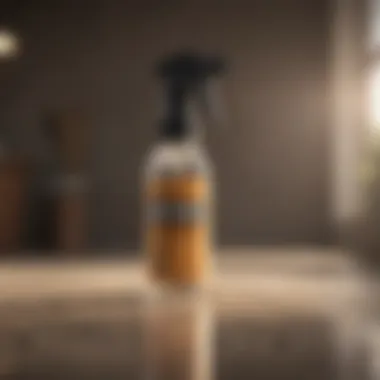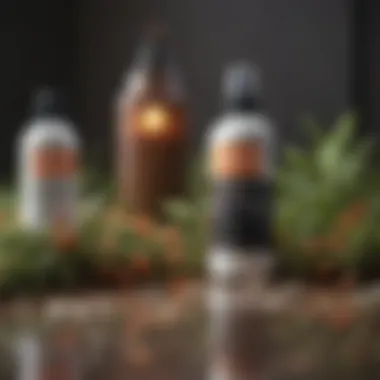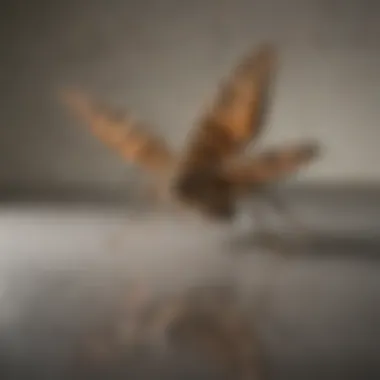Effective Moth Control: Best Sprays for Infestations


Intro
Moth infestations pose a serious threat to domestic environments, particularly targeting clothing, fabrics, and foodstuffs. Understanding the biology and behavior of these pests can help in selecting the most effective control measures. As homeowners grapple with moth-related damages, the need for knowledge about suitable sprays becomes increasingly relevant. This article will elucidate the various types of sprays available for moth control, the active ingredients responsible for their efficacy, and proper application methods. Further, we will emphasize safety precautions and explore how these solutions can be integrated with non-chemical approaches.
Key Insights and Trends
Contemporary pest management strategies increasingly emphasize a blend of chemical and non-chemical methods. For moth control, the focus is shifting towards more sustainable solutions. Homeowners are seeking out effective sprays that not only eliminate moths but also minimize environmental impact. This shift is fueled by rising awareness of health and safety issues associated with chemical exposure.
Moreover, trends in home organization and textiles are relevant. It’s common to see a rise in wool and cotton fabrics marketed for upholstery and clothing. However, these same materials attract moths, necessitating a proactive control strategy. The synergy between choosing appropriate materials and effective pest control should be a cornerstone of any home maintenance plan.
Types of Sprays for Moth Control
Various sprays are available on the market, each with unique compositions aimed at targeting moths effectively. The most commonly used sprays include:
- Insecticidal Sprays: These contain potent active ingredients like pyrethrins or permethrin, which target adult moths upon contact.
- Repellents: These sprays do not kill moths but deter them from infesting an area, often utilizing natural essential oils such as cedarwood or lavender.
- Residual Sprays: These are designed to stay effective for a longer period. They are often used in places where moths are likely to return.
Practical Tips for Moth Control
For effective use of sprays, consider the following practical tips:
- Identify the Infestation: Before applying any spray, ensure you have accurately identified the presence of moths in your home.
- Select the Right Product: Choose a spray specially formulated for moths to ensure optimal effectiveness.
- Follow Instructions: Always adhere to the manufacturer's instructions for application, safety precautions, and re-entry times.
- Protect Your Belongings: Ensure items that may be damaged by sprays are properly covered or removed during application.
- Integrate Non-Chemical Methods: After applying sprays, employ traps or natural pheromones to supplement control efforts.
Effective moth control requires a holistic approach, combining sprays with preventive measures.
By employing a thorough understanding of moth behavior and an informed selection process, homeowners can cultivate a pest-free environment.
Understanding the Moth Problem
Moths represent a significant threat to various household items, especially clothing and fabrics. Understanding the moth problem is crucial for several reasons. First, moth infestations can lead to extensive damage, ultimately resulting in costly replacements. Additionally, moths are not merely a nuisance; their presence indicates a larger problem that needs addressing. By grasping the nature of this pest, homeowners can take informed steps to prevent and eliminate infestations effectively.
Identifying Common Types of Moths
There are several species of moths that homeowners might encounter. The most common include the Clothes Moth and the Pantry Moth.
- Clothes Moths: These are small, about half an inch long, and are known for their destructive larvae. They feed on wool, silk, and other natural fibers, making them a common issue for clothing.
- Pantry Moths: Also referred to as Indian Meal Moths, these tend to infest stored food products. They are particularly attracted to grains and dried fruits. Knowing the type of moth present helps in selecting the appropriate control method.
Recognizing these types early can prevent serious damage and infestation escalation.
Understanding Moth Behavior and Lifecycle
Moths undergo a complete metamorphosis, consisting of four stages: egg, larva, pupa, and adult. The understanding of their lifecycle is essential for effective control. Eggs are typically laid in dark, hidden spaces, often in fabrics or food supplies. Once hatched, the larvae - which are the destructive stage - begin to eat and grow.
- Egg Stage: Invisible to the naked eye, eggs can be found in infested materials.
- Larval Stage: This is the stage where the most damage occurs. Larvae create holes in fabrics and are the main concern for homeowners.
- Pupal Stage: Pupation occurs in hidden locations, often resulting in a new generation of moths.
- Adult Stage: Adults are primarily focused on mating and laying eggs, thus continuing the cycle.
Recognizing these stages allows for targeted interventions, increasing the chance of eradication.
Common Signs of Moth Infestation
Detecting moth infestations early leads to timely intervention. Here are common signs to look for:
- Visible Damage: Holes or frayed edges in clothing and textiles are a primary indicator.
- Larvae Presence: Finding larvae often indicates a current problem. They are typically found in dark areas, such as closets or pantries.
- Webbing: Some moths create silk webbing that can be visible on your clothes or pantry items.
- Adult Moths: Seeing adult moths flying around is a clear sign of an infestation.
"Recognizing the signs of a moth infestation early can save belongings from irreversible damage."
By understanding these indicators, homeowners can act swiftly to mitigate destruction.


Sprays: A Viable Solution
The use of sprays for controlling moth populations presents a practical and efficient method for managing these pests in various environments. Sprays act quickly, effortlessly targeting both adult moths and their larvae, thus addressing different stages of the moth lifecycle. This section discusses their significance, the types of sprays available, and the active ingredients that define them.
Different Types of Moth Sprays
Different types of sprays are designed to combat moth infestations. Understanding each kind helps homeowners select the best option for their needs.
Chemical Sprays
Chemical sprays are formulated with synthetic compounds that effectively eliminate moths upon contact. Their rapid action is a key characteristic, making them popular for immediate intervention. Products containing pyrethroids, for example, offer fast knock-down effectiveness against adult moths. However, long-term reliance on chemical agents can lead to resistance. The main advantage of chemical sprays is their high efficacy, but the potential risks to non-target organisms requires careful consideration during use.
Natural Sprays
Natural sprays utilize plant-based ingredients and offer an alternative for those seeking environmentally friendly solutions. Typically comprised of essential oils, these sprays tend to have a pleasant scent, which can enhance their appeal. The key characteristic of natural sprays is their lower toxicity to humans and pets, making them an attractive choice for households. Nevertheless, their effectiveness may vary, and they often require more frequent application compared to chemical options.
DIY Options
DIY options are customizable solutions that homeowners can create using common household items and natural ingredients. One of the main benefits of DIY moth sprays is cost-effectiveness; individuals can mix essential oils with water and a mild soap to form a solution. Besides, these sprays do not contain harsh chemicals. However, their effectiveness can be inconsistent, and some users may find the results vary based on the ingredients used.
Active Ingredients in Moth Sprays
The effectiveness of moth sprays greatly hinges on their active ingredients. These components determine a spray's efficiency and safety.
Pyrethroids
Pyrethroids are synthetic insecticides based on naturally occurring compounds found in chrysanthemum flowers. Their ability to target the nervous systems of moths gives them a unique advantage in insect control. They are favored for their quick action against adult moths and worms. However, one must note that extensive usage could impact beneficial insects negatively, raising concerns among environmentally conscious consumers.
Essential Oils
Essential oils serve as natural alternatives, derived from various plants. Oils such as lavender, cedarwood, and peppermint not only repel moths but can also provide a pleasant aroma for the home. The organic nature of essential oils is appealing, particularly for those with children and pets. However, they may not provide the same level of immediate effect as synthetic chemicals, requiring diligence in application.
Other Common Ingredients
Other common active ingredients include various botanical extracts and inert substances. These can range from food-grade materials to safe-to-use compounds effective against moths while being less harmful to the environment. The versatility of these ingredients allows for a combination approach, appealing to a wider range of consumers. Nevertheless, their effectiveness can often be less predictable than more potent synthetic options.
Application Techniques
Application techniques are crucial when using moth sprays effectively. Understanding the methods of application can enhance the impact of the sprays, ensuring that they reach their intended targets. Proper techniques can minimize waste and maximize the effectiveness of the sprays. This can lead to a quicker resolution of moth issues and reduce the likelihood of recurring infestations.
How to Properly Use Moth Sprays
To properly use moth sprays, start by reading the manufacturer’s instructions. This ensures you are aware of the specific application method recommended for that product. Generally, aim to spray areas where moths are likely to hide or where they have previously been spotted. This includes closets, attics, and around windows.
It is also essential to shake the spray bottle well before use. This mixes the ingredients properly and ensures an even distribution. Apply the spray in a sweeping motion. Keep the can at the distance recommended in the instructions to avoid concentrated spots that may damage your belongings.
Best Practices for Effective Application
Choosing the Right Environment
Choosing the right environment for applying moth sprays is vital. Ideally, you should operate in a space that is dry and free from drafts. This allows the spray to adhere better to surfaces, increasing its efficacy. Applying in a closed space can enhance the concentration of the spray, which is often necessary for effective moth control.
However, it is important to ensure that the room is clear of people and pets. This minimizes exposure and enhances safety during and immediately after spraying. The key characteristic here is that having a controlled environment leads to better results. While this may limit when you can spray, it often results in the most effective pest control.
Timing of Application
Timing the application is another significant factor. Early morning or late evening is often preferred because moths are typically more active during these hours. Spraying during these times can increase the likelihood that the product reaches the moths before they settle.


Another consideration is ensuring that there has been no recent rainfall if you are spraying outdoors. Wet conditions can dilute the effectiveness of the spray. The unique feature of timing is that it correlates directly with moth behavior, providing a strategic advantage in pest control.
Preventing Overspray
Preventing overspray is critical for effective application. Overspray can lead to unintended damage to your belongings and waste of products. Utilize cardboard or plastic sheets in areas where overspray may occur. This simple method protects surfaces while maintaining the focus on targeted areas where moths are present.
Practicing controlled spritzes rather than continuous spraying can further minimize overspray. Ensuring precise application will reduce harm to non-target areas, making it a beneficial approach for this article.
Safety Precautions When Using Moth Sprays
Safety is paramount when using chemical sprays. Awareness of protective measures can prevent mishaps and ensure user safety.
Protective Gear
Wearing protective gear is essential when applying moth sprays. Items such as gloves, masks, and goggles can shield against exposure to harmful ingredients found in many chemicals. This step is necessary not only for safety but also for peace of mind during application.
The key advantage of using protective gear is that it reduces the risk of skin irritation or respiratory issues. It is an easy yet effective way to prioritize personal safety during pest control efforts.
Ventilation Requirements
Proper ventilation is another critical component. Make sure that windows are open, and fans are running to ensure good air circulation during application. This reduces inhalation risks associated with chemical exposure.
Well-ventilated areas can alleviate the intensity of the spray’s odor and help it dissipate quickly. Thus, ensuring ventilation is not just good practice; it is vital for health considerations.
Storage and Disposal
Finally, correct storage and disposal of moth sprays is important. Store sprays in cool, dry places away from children and pets. Following disposal guidelines, as stated on the product label, is also essential. Mismanagement of leftover products can result in contamination or accidental exposure.
Overall, understanding these practical considerations not only enhances the effectiveness of moth sprays but also supports safety and long-term effectiveness against future moth infestations.
Combining Chemical and Non-Chemical Methods
Combining chemical and non-chemical approaches to moth control creates a more effective strategy for managing infestations. While chemical sprays can quickly address an immediate moth problem, integrating non-chemical methods can help provide long-lasting solutions. A comprehensive approach ensures that chemical solutions do not solely rely on their effectiveness but are supported by preventive and sustainable measures. This combination minimizes the risk of moths developing resistance to chemical sprays, prolonging the impact of both methods.
Non-Chemical Approaches to Moth Control
Regular Cleaning
Regular cleaning is a foundational strategy in moth control and contributes significantly to preventing infestations. This method involves routinely vacuuming and dusting areas where moths may settle, such as closets, storage spaces, and corners of rooms. The key characteristic of regular cleaning is its simplicity and accessibility. It doesn’t require special expertise or equipment, making it a widely appreciated choice.
Unique features of regular cleaning include the elimination of eggs and larvae. These pests often hide in fabrics and corners, and keeping these areas clean reduces the likelihood of infestations. The main advantage is that it provides a preventive measure without introducing chemicals into the environment. However, a disadvantage could be the need for consistent effort; neglecting this can lead to re-infestation over time.
Use of Deterrents
Deterrents serve as another viable, non-chemical method for moth control. They can be natural or synthetic and are designed to repel moths from areas where they may lay eggs. Common deterrents include essential oils like lavender, cedar, and mint, which have proven effectiveness. The key characteristic of using deterrents lies in their dual function: they are safe for the environment and provide a pleasant aroma to your home.
The unique feature of deterrents is their ability to create a hostile environment for moths without killing them outright. This method can be seen as beneficial because it aligns with a more eco-friendly lifestyle. The downside might be that, while effective, they may not offer permanent solutions and should be used as part of a broader moth management strategy.
Traps and Monitoring
Traps and monitoring are essential components of a comprehensive moth control plan. These tools allow homeowners to detect and assess the level of moth presence, which guides further action. The main characteristic of traps is their effectiveness in capturing adult moths, thus preventing them from reproducing and spreading.
An important unique feature of traps is their ease of use and low maintenance. Monitoring traps can provide valuable information about the moth species present, which can aid in determining the most effective treatment plan. However, one disadvantage is that traps may not address the larvae stage, which is crucial for effective moth control. While traps help monitor, they need to be combined with other methods for adequate control.
Integrating Sprays with Other Methods


Integration of sprays with other methods ensures a holistic approach to moth management. Using sprays in combination with regular cleaning, deterrents, and traps results in a more thorough strategy. Each element complements the others, resulting in a more effective way to tackle moth problems without relying solely on one method.
Case Studies of Effective Spray Use
Understanding real-life applications and outcomes of moth spray products offers valuable insights into their effectiveness. Case studies serve as a critical resource, showcasing actual experiences from households that have confronted moth infestations. These examples not only illustrate the potential benefits of using sprays but also reveal practical considerations that individuals must account for when selecting and applying these products. A thorough analysis of case studies can help homeowners make well-informed decisions based on concrete evidence.
Success Stories from Households
In many households, successful control of moth populations has been documented through the strategic use of sprays. For example, one family in a suburban area was struggling with a persistent moth issue in their wardrobe. After identifying the specific type of moth, they opted for a chemical spray containing pyrethroids, which are well-regarded for their efficacy in dealing with adults and larvae alike. After diligent application following the product's guidelines, this family reported a significant reduction in moth sightings within two weeks. This case exemplifies how targeted approaches can lead to rapid and effective outcomes.
Another instance involves a couple who employed a natural spray featuring essential oils like lavender and cedarwood. They noted improvement not only in the insect control but also in the pleasant fragrance that these oils left behind. The couple highlighted the benefit of using a product without harsh chemicals, which made it a safer option for their pets and children. Their satisfaction underscores the growing demand for natural alternatives in pest control.
These success stories emphasize that approaching moth problems with the right product—coupled with proper technique—can yield positive results.
Analysis of Product Effectiveness
To comprehend the effectiveness of different moth sprays, analyzing product performance through documented case studies becomes indispensable. Each product comes with its unique formulation, which impacts its overall efficacy. For example, sprays based on synthetic pyrethroids tend to act quickly against adult moths, but might require repeated applications to manage larvae effectively. Alternatively, natural sprays, while generally safer, may take longer to produce visible results and might not eliminate moth populations as rapidly.
In various case studies, feedback varies based on application methods and environmental factors. One homeowner reported that a commonly used spray required multiple applications to sustain control, while another noted a product with a quick action time but persistent odor issues. Thus, individual experiences can vary widely based on several factors:
- Application Technique: Proper spraying technique is crucial. Spraying directly onto fabric and into cracks can enhance effectiveness.
- Type of Moths: Not all sprays are equally effective. Some sprays target specific species, which can lead to better results when the pest is correctly identified.
- Environmental Impact: Consideration of pets, children, and delicate fabrics is important. Natural options may be preferred in these cases.
Understanding the effectiveness of a product is not just about its active ingredients; it's also about how well it is applied and the context in which it is used.
Preventing Future Infestations
Preventing future moth infestations is critical, especially if you have already dealt with these pests in the past. Moths can cause significant damage to clothing, furniture, and other materials, creating a sense of urgency for effective prevention strategies. There are various elements to consider when it comes to safeguarding your home and belongings from moths. This section outlines effective long-term strategies that not only help in controlling existing populations but also proactively protect against future invasions.
Long-Term Moth Prevention Strategies
Long-term prevention strategies rely on a combination of proper habits and effective products. Three main tactics play a significant role in ensuring your home is inhospitable to moths: proper storage of clothing, the use of moth repellents, and regular inspection and maintenance.
Proper Storage of Clothing
Proper storage of clothing is essential in preventing moth infestations. When clothes are not stored correctly, they can attract moths, which may lead to considerable damage over time. One key characteristic of proper storage is using airtight containers. These containers can keep moths out by eliminating exposure to air, which moths use to navigate and reproduce. Storing garments in vacuum-sealed bags is another effective practice.
This storage method not only protects your clothing but also creates a barrier against moisture, which moths prefer. Therefore, this strategy is a highly beneficial choice for prevention efforts. However, be cautious. Vacuum-sealed bags can trap moisture, leading to mildew if not dried properly before sealing.
Use of Moth Repellents
The use of moth repellents plays a vital role in ensuring clothing and other fabrics remain safe from moth damage. Options such as lavender sachets and cedar chips are popular choices among homeowners. They are natural alternatives that deter moths without harsh chemicals. One notable advantage of using natural moth repellents is their pleasant fragrance, which can freshen up spaces while serving a functional purpose. However, their effectiveness might vary. It is important to replace them regularly to maintain adequate protection.
On the downside, some chemical repellents could pose risks to health and the environment. Therefore, homeowners should weigh these factors before choosing the right products for their needs.
Regular Inspection and Maintenance
Regular inspection and maintenance can significantly contribute to long-term moth prevention. Conducting periodic checks of closets, attics, and storage areas helps identify early signs of infestations. Being proactive in this manner can prevent severe damage before it occurs. The key characteristic of regular inspection lies in its deteciton aspect. Spotting a few moths or larvae can guide you in taking prompt actions before the problem escalates.
Most people overlook this method, which makes it a beneficial choice. Maintenance practices, such as frequent cleaning and reorganizing stored items, not only keeps things tidy but also helps reduce potential hiding spots for moths. This method involves effort but can be highly effective in maintaining a moth-free environment.
"Taking consistent steps to prevent moth infestations can save you from potential regrets later when damage is already done."
The End
Effective moth control is a critical topic for many homeowners, especially those who value their belongings and want to maintain a moth-free environment. This article seeks to consolidate essential information about using sprays for moth control, addressing both the practical aspects of application and the broader preventative strategies. Sprays can provide immediate relief from infestation, but understanding their proper use is equally important to ensure lasting effects.
The concluding section emphasizes the significance of combining knowledge of moth behavior and effective spray usage. By recognizing what attracts moths and applying the right products, homeowners can not only eliminate existing problems but also thwart future infestations. Knowledge about the different types of sprays, alongside their active ingredients, creates a foundation for informed decisions when selecting the right option.
Moreover, understanding safety precautions cannot be understated. It safeguards not just the household members but also the environment. Responsible application and disposal of chemicals should always be at the forefront of any pest control plan.
Summary of Best Practices
- Identify the Type of Moth: Different species may require different approaches. Knowing what you’re dealing with helps tailor the solution.
- Choose the Right Spray: Select a product that fits your needs, whether it’s a chemical or natural option. Consider factors, like effectiveness and safety.
- Follow Application Guidelines: Adhere to instructions for proper use. Timing and environment influence effectiveness.
- Ensure Safety: Wear protective gear and ensure adequate ventilation before applying sprays.
- Integrate with Other Methods: Combining spray usage with non-chemical strategies will maximize effectiveness and provide a more holistic approach. Regular cleaning and monitoring play an important role in long-term prevention.



